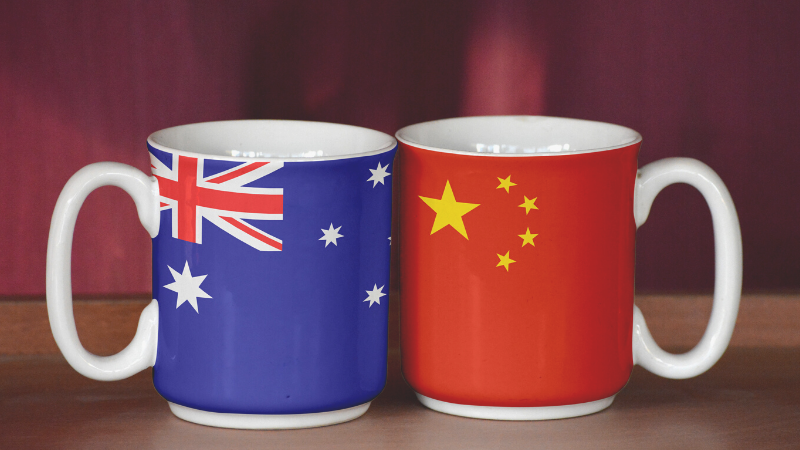PERSPECTIVES | Australia and Taiwan: Between the PRC and the US
April 24 2024

Perspectives is UTS:ACRI's commentary series, featuring a piece on a topical subject in the Australia-China relationship from an invited expert contributor.
By Kevin Magee
A view of the Australian foreign policy environment reveals a policy mountain range dominated by two peaks, the People’s Republic of China (PRC) and the US, with Taiwan nestled in between.
One peak, the PRC, is Australia's number one trading partner by far. Australia’s wealth is to a large degree dependent on the PRC – a market that receives about 30 percent of Australian exports. The other peak, the US, has been Australia’s security guarantor since 1942 with the arrangement being formalised through the ANZUS Treaty in 1951 and supercharged recently by the AUKUS security partnership and membership of the Quad.
Relations between Australia and the PRC have thawed since the deep freeze it entered into from around the latter half of 2016 to 2022. The Albanese government has worked consistently to ‘stabilise’ the relationship since its election in the May 2022 federal election with the result that the bulk of Beijing’s trade sanctions have been removed – although restrictions remain on lobster and some meat establishments – and high level dialogue and visits have resumed. In parallel, the Labor government has remained firm in its support for AUKUS, the US alliance and other national security measures, most recently further tightening Australia’s export controls regime.
Canberra’s strong adherence to the security relationship with the US means there are limits to how far Australia’s relationship with the PRC can improve. Australia is committed to supporting US primacy in the Western Pacific and has championed the two pillars of AUKUS: the acquisition of nuclear-powered submarines and intelligence and technology sharing. As part of the Quad, Australia has joined its partners the US, Japan and India in countering PRC interests. Australia has engaged in joint exercises with the US, Japan and the Philippines, and the Royal Australian Navy has sailed through the Taiwan Strait. This accentuates a fundamental contradiction in Australia’s geopolitical and geoeconomic position in the Indo-Pacific between its economic and trade interests and its national security and strategic interests.
In the midst of this Australian policy contradiction sits Taiwan. Taiwan is important for Australia – it was Australia’s seventh largest two-way trading partner in 2022-23 and sixth largest export market, as well as being a democracy with friendly relations with Australia. Despite Beijing’s mixture of pressure, blandishments and threats to Taiwan, the Taiwanese people have displayed no desire for unification. The major political parties in Taiwan regard the Republic of China (Taiwan) as already sovereign and independent with no need to formally declare independence from the PRC.
Australia’s commitment to its one China policy and the need to balance PRC interests has led to another contradiction in Australian policy based on the reality of the limitations on the development of links between Australia and Taiwan. The Albanese government has sought to achieve a balance with the PRC and engage in a moderate expansion in links with Taiwan but always within the limits of the one China policy. Despite a desire to apply the policy in a flexible manner there have been hard barriers, which Australia has not crossed. No Australian minister has visited Taiwan since 2012 and Australia has not proceeded with a free trade agreement with Taiwan, nor actively supported Taiwan’s accession to the Comprehensive and Progressive Agreement for Trans-Pacific Partnership (CPTPP).
Historically the defence of Taiwan has not been a priority for Australia, but this appears to be changing. Interoperability between Australia and US forces is growing. Earlier this month, US Deputy Secretary of State Kurt Campbell suggested that the Washington would expect Australia to use its AUKUS submarines to defend Taiwan. In October 2023, Deputy Prime Minister and Defence Minister Richard Marles said Australia could not be a ‘passive bystander’ in the event of conflict in the Taiwan Strait. It is safe to say, therefore, that in the event of conflict over Taiwan involving the US there is little doubt that Australia would be part of US military action.
Many American military leaders and sections of the media have talked up the likelihood of war in 2027. While there is no strong evidence of imminent war in the Taiwan Strait, it is expected that the PRC will keep its political-military pressure up on Taiwan. According to recent interviews with observers in Taiwan, the majority of Taiwanese do not see war as imminent and life continues in Taiwan very much as normal. The Taiwan government remains committed to defending the island and the US has been increasingly supporting and arming Taiwan. There is, nonetheless, in Taiwan a strong feeling of uncertainty about the willingness of the US to defend Taiwan in light of its position of ‘no boots on the ground’ in Ukraine and its withdrawal from Afghanistan. Given the fact that a US-PRC conflict would mean war between two nuclear-armed countries, nuclear considerations will also weigh heavily on both major nations.
Beijing officially is committed to the ‘peaceful reunification of Taiwan’ unless Taiwan declares independence. Nonetheless, Taiwan and the South China Sea have become points of confrontation between the Washington and Beijing in their struggle for dominance in the Western Pacific.
However, a war or a PRC blockade of Taiwan are unlikely at the moment. Any form of cross-Strait conflict would lead to war, with significant loss of life on all sides and the potential destruction of Taiwan and its globally vital microchip industry. A war or blockade would damage the global economy and the economic cost to all parties involved, including Australia, would be significant. A PRC invasion would be a risky proposition that could fail and a defeated invasion would be considerably damaging to the Chinese Communist Party’s status. These factors act as brakes on both Washington or Beijing moving towards war, as well as on Taiwan seeking to declare independence.
Taiwan is likely to remain de facto independent but under persistent and strong PRC pressure for the foreseeable future. Australia will continue to face the challenge of balancing its relations with the PRC and Taiwan as tensions simmer and as it continues to support peace and stability and the status quo across the Strait.
The status quo can survive as long as the US dominates the Western Pacific and is willing to defend Taiwan. The PRC will play the long game unless provoked by a declaration of independence. Taiwan knows that declaring independence is a losing hand to play and will adhere to the status quo. Only if the US loses its position of primacy and hegemony in the Western Pacific, then will Taiwan need to find a new accommodation with the PRC and possibly some form of association or unification with the mainland. This, of course, is uncertain but domestic developments in the US, especially under a second Trump administration, leave the possibility open. For the moment, for Australia and for the region, the maintenance of the status quo remains the best option and it is possible that Taiwan will remain de facto separate from the PRC indefinitely.
Kevin Magee is an Adjunct Fellow at the Australia-China Relations Institute, University of Technology Sydney.

